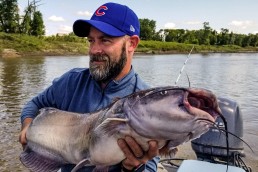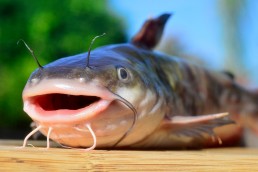Lateral Movement for Catfish
SHARE THIS POST
For months now we have been discussing seasonal patterns, barometer and water temperature. All of this plays into being a successful catfish angler. It was all in preparation for this special lesson on an intricate patterning trick that, once understood, can catch you many more fish with very little effort. It is called lateral movement.
In short, lateral movement is the theory that catfish do not move up- and downstream when conditions change, but rather side-to-side. Lateral movement can be as simple as being on current versus off current. In lakes, it can be moving from a shallow 6 feet to a 10-foot drop off.
The history of the lateral movement theory
Fishing on- versus off-current has been around since the beginning of catfishing, but had never really been explained. When you look back to old articles, books and videos, they always talk about fishing structure elements such as snags, fishing in holes or outside bends of rivers. All of this is fishing current in some way, shape or form. The only exception was when In-Fisherman discussed fishing current tunnels under tailraces in some of their videos.
In 2010, when I was having my first bout with ever-changing water levels, I was trying to figure out where the fish went during big swings in water level. I was struggling with falling water more than anything, and was on a stretch of fishing that had me rethinking my career choice.
One fateful evening when I was on a low in catfishing, I saw this little snag pile and thought, “What the heck?” I pulled in, threw bait and, to my surprise, was catching fish like crazy. I happened to look at the water, and there was cotton from the trees all over the surface. Just to my right, the cotton in the main river was screaming by, but where my baits were placed was moving about half the speed. This is where I established secondary current and the term “off-current.” I took note and repeated what I saw, and we had a great day of fishing.
Over time, I figured out how to read secondary currents, and took notes on when the fish would move on or off the current. Either way, they were never very far from the main current seam. Now, put the term lateral movement in. Cast into the current, or out of it.
Taking it a step further, I found that in areas that have everything a catfish wants, such as shallow water, deep water, wood, fast water and slow water, that when a front or something changes the bite, the fish don’t go up- or downriver, but rather move side-to-side to whatever they want that is there. No need to move miles, when all you have to do is adjust your cast to a different structure type.
The reason the fish will move out of current is, something tells them to get to an area where they expend the least amount of energy possible. We as anglers tend to not look there, because we were all taught to fish aggressively.
An example of this is, for days, the fish are feeding right in the middle of the river, at the head of a hole in the fastest current. A big front goes by and…no fish. Simply move 20 yards to the inside bend near the same hole, but off current, and put the bait in the snag that formed from a fallen tree.
As you can see, this info is very important to understanding how to stay on fish through all situations.
Using lateral movement
Lateral movement is much simpler than you may think. In many situations, it just means to cast left instead of right from the same spot you normally fish. In other cases, it means anchor on the opposite side of the river than you normally do. But in any case, it is a much smaller adjustment than many think.
Are you enjoying this post?
You can be among the first to get the latest info on where to go, what to use and how to use it!
In spring, when the water is high and still somewhat cold, it is best to get out of the current, or as “off current” as possible. This is usually the back of an inside corner, or in front of the turn on an outside corner, where the current is screaming by.
Once prespawn is in full swing, not much shuts the fish down. But they will move in and out of the main current. After a front or a rise or fall in water levels, the fish may move from the main current seam to just out of the current. They will work the flat that is usually on the top of the shelf, out of the main current. Another way to fish this pattern is to anchor on the inside bend, but cast out into the current and let your lines get pulled back to the break. This is an often-overlooked trick to get off current.
The biggest place to use lateral movement occurs in summer, when the fish tend to take up residence in areas of river that possess everything. Of course, fish move up- and downstream, but they tend to like traditional areas that have everything previously mentioned, such as deep water, shallow water, wood, fast water and slack water.
When conditions are stable and fish are feeding, you can fish the head of the hole, the fast water or the outside bend of the area, which usually contains both of the previous. Should there be a front or a fluctuation in water level, the fish might move to the back of the hole, completely out of the current, or just off the main current. You should not have to move the boat much to find these spots; just make a minor adjustment in bait placement.
Likewise, if you have been fishing off current and the weather changes to the positive or stable, catfish will move into the fast water or head of a hole. Keep in mind that fish can move back and forth throughout the same day.
Lateral movement seems like a very big term, but it is a simple theory that can catch you a lot of fish, with just very simple adjustments to how you already fish. MWO
Captain Brad Durick is a nationally recognized catfish guide, seminar speaker, and author of the books Cracking the Channel Catfish Code and Advanced Catfishing Made Easy. For more information: redrivercatfish.com or facebook.com/braddurickoutdoors.
This catfish is a perfect example of lateral movement. The fish had been feeding in the main current, but a storm system shut them down, pushing them out of the current. We moved from the middle of the river to near the bank, in a snag that had nearly no current: a simple lateral adjustment to find a big fish.
Catfish had been in areas of little current, but due to stable warm weather, moved to the main current to feed aggressively.
MWO
SHARE THIS POST
Did you enjoy this post?
You can be among the first to get the latest info on where to go, what to use and how to use it!
Brad Durick
Captain Brad Durick is a nationally recognized catfish guide, seminar speaker, and author of the books Cracking the Channel Catfish Code and Advanced Catfishing Made Easy. For more information: redrivercatfish.com or facebook.com/braddurickoutdoors.



